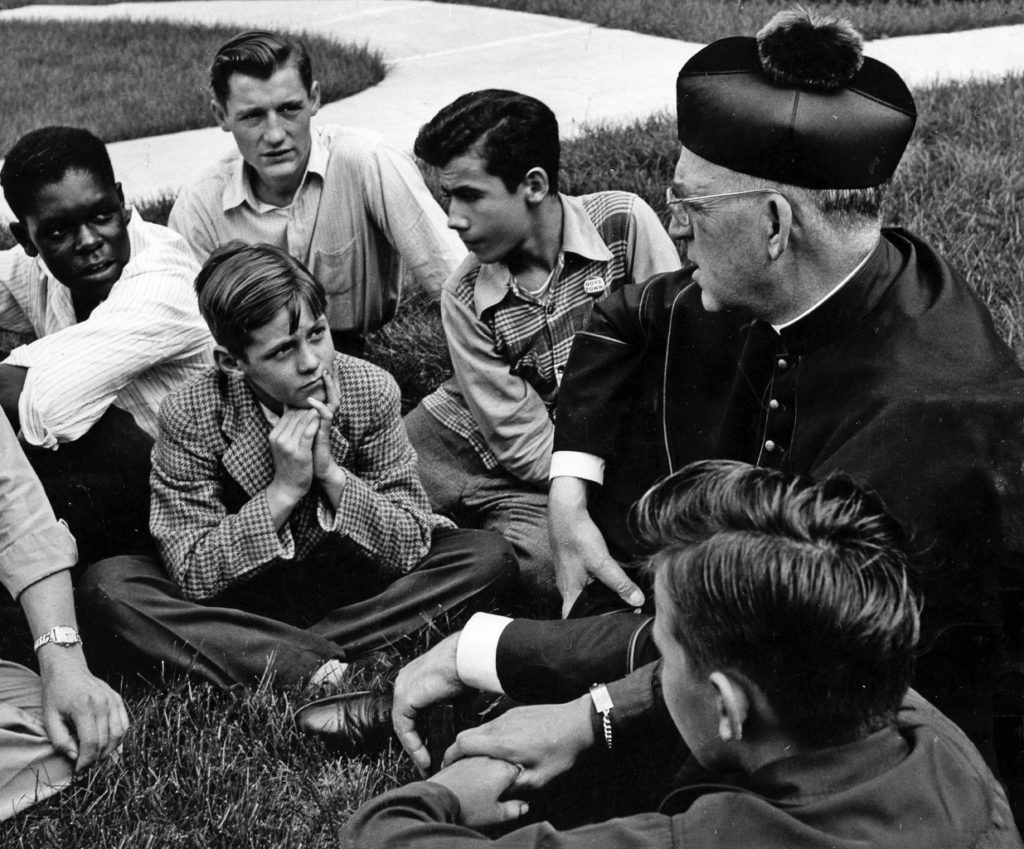My previous knowledge of Father Edward James Flanagan didn’t extend past a synopsis of the 1938 film “Boys Town,” starring Spencer Tracy and a teenaged Mickey Rooney. A good film with some praiseworthy performances, the appraisal it got from critics 86 years ago still holds up: a “tearjerker” with an overly sentimental fictionalized version of a real place and a real man.
Thankfully, the new documentary “Heart of a Servant” rectifies all that.
Produced by Spirit Juice Studios and distributed by Fathom Events, the film starts with Flanagan’s beginnings in a large Irish family. Although a sickly child from birth, his interior calling — and intellect — brought him to the seminary. Upon ordination, the new priest went the same direction as so many of his fellow Irish priests at the time: west to America, where he soon found himself in a place as different from Ireland as one could find: Nebraska.
On his own initiative he established a shelter for men struggling during the First World War. Finding their unhealthy habits so ingrained, he thought it might be easier to redeem a boy in trouble before they became a man in trouble. The social and economic upheaval in the U.S. at the time meant there were plenty of boys living on the street or in group homes who needed redeeming. Flanagan’s dream of a self-sustaining “city” called Boys Town was born.
“Heart of a Servant” breaks no new ground as far as documentary filmmaking goes, but it does have top production elements and star actor Jonathan Roumie of “Chosen” fame as its capable narrator. But its structure resembles a long-form honoree video one sees at a fundraising gala. It also uses some file footage of Hollywood premiers that were not of the same era of Father Flanagan (which only a movie geek like me would notice).
But such “flaws” don’t get in the way of one of the most inspirational stories none of us know enough about.
Boys Town was revolutionary in its emphasis on compassion instead of punishment for throwaway boys. Flanagan created the ultimate “safe space” where the boys governed themselves, had a newspaper, trade schools, and the kind of athletic and educational opportunities they could have found nowhere else. When local officials informed the priest that having boys of different races living in the same quarters and going to the same school was illegal and ill-advised, Flanagan didn’t waver. The film dramatically conveys the tenor of these times with newsreel footage of a large Ku Klux Klan march not in Selma, Alabama or Biloxi, Mississippi, but right down the middle of Pennsylvania Avenue in Washington, D.C.
Flanagan’s response was simple and humble. Boys Town would be a real town with its own ordinances and rules and none of them would say anything about a boy’s race, creed, or ethnic background. Problem solved.
Despite never fully recovering his health, Flanagan expanded Boys Town through the Great Depression and World War II, when he encountered another social injustice. The film tells how Flanagan responded to a letter from a girl living in a Japanese American girl internment camp by inviting her and her family to come live at Boys Town. Eventually 200 Japanese Americans would call Boys Town (and all it had to offer) their temporary home until the injustice of internment was reversed.
The film’s most wistful moment comes just after the war, when the priest returns home to Ireland to be feted as a conquering hero of sorts, a lad who made good in America. But as he toured the industrial schools and homes for wayward boys and girls in Ireland, Flanagan was horrified at what he saw. He wanted to stay in Ireland and reform this system.
His adoptive country had other plans, though, sending him to war-ravaged Japan and Europe to assess what might be done for children there. He dutifully obeyed and we are left to wonder how things in Ireland might have been so different. The Irish government and hierarchy took great offense to Flanagan’s assessment of their network of “charitable” industrial schools and group homes for boys and wayward girls and the status quo was maintained. Unfortunately for both the Irish government and the Church, the cruelty and spiritual abuse of these institutions, untouched by Flanagan’s reforms, would be exposed many decades later.
Many of those interviewed in “Heart of a Servant” see Flanagan as a saint. It is hard to argue against it. Named a Servant of God in 2012, his piety, humility, devotion to the Eucharist, and his courage certainly seem to be living by the Gospel playbook.
Flanagan was a giver, and this film gives the viewer a chance to be a taker. At the very beginning of the film, we learn that as a sickly child, young Eddy Flanagan’s family gave him the job of tending to the sheep because as he put it, “he was not good enough for much else.”
I would call that on-the-job training for the life he lived. In the case of E.J. Flanagan, it was certainly good enough.
“Heart of a Servant” will be shown in theaters nationwide as part of a one-day release on Tuesday, Oct. 8. Local showtimes are available here.

